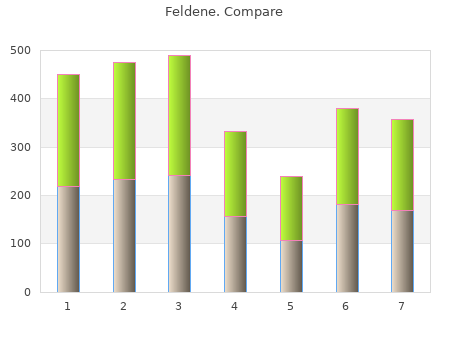2017, Saint Bonaventure University, Temmy's review: "Feldene 20 mg, 10 mg. Safe online Feldene OTC.".
An ultrasonographic image in the axial (transverse) plane of the patellar tendon of a 31-year-old man reveals a characteristic hypoechoic region in the patellar tendon discount 20mg feldene overnight delivery. This appearance corresponds with tendinosis (collagen degeneration) 10mg feldene overnight delivery. Patients perform 3 sets of 10 repetitions continue to train and play with pain. This traditional grams are particularly useful to athletes who treatment program emphasizes training speci- have failed a pain-free conservative program ficity, maximal loading, and progression. They are best completed dur- Maximal loading occurs when patients feel ing the off-season, when training commitments their tendon pain in the final set of 10 repeti- are greatly reduced. Progression is achieved by increasing the speed of movement or by increasing the exter- Prescribing Eccentric Exercise: nal resistance, again using pain as a guide. Ice is used to cool the tendon after the eccentric Clinical Experience training. Therapists often have concerns as to when and Following the success of a pain-based eccen- how they should begin a strengthening program. Outline of strengthening program for treatment of patellar tendinopathy muscles to take over the exercise. Similarly, we Timing Type of overload Activity have found that squats performed on a 25 degree decline board are effective in reducing the influ- 0–3 months Load endurance Hypertrophy and strengthen the affected muscles; focus ence of the calf group in retarding knee flexion attention on the calf as such as occurs in a normal squat done with the well as the quadriceps and heels fixed. These end-stage eccen- tric exercises can provoke tendon pain, and are only recommended after a sufficiently long with strengthening exercises. In several sports it and timelines that our clinical experience has may not be necessary to add height to the reha- shown to be effective.

The formation of a metal–oxide passive film on a metal surface is one example of a kinetic limitation to corrosion 20mg feldene otc. The general reaction that governs this formation is as follows: z + z z − M HO2 MO zH ze 2 (5) In general generic feldene 20mg mastercard, kinetic barriers to corrosion prevent either the migration of metallic ions from the metal to the solution, the migration of anions from solution to metal, or the migration of electrons across the metal–solution interface. Passive oxide films are the most well known forms of kinetic barriers in corrosion, but other kinetic barriers exist including manufactured polymeric coatings. Table 1 Standard Electrochemical Series for Selected Metals Reaction Potential (V) Noble (corrosion resistant) Au3 3e ⇔ Au 1. The more noble metals at the top of the list are less reactive, while the more active metals toward the bottom are more reactive and have a higher driving force for oxidation (corrosion). Orthopedic alloys rely almost entirely on the formation of passive films to prevent signifi- cant oxidation (corrosion) from taking place. These films consist of metal oxides (ceramic films) which form spontaneously on the surface of the metal in such a way that they prevent further transport of metallic ions and/or electrons across the film. To be effective barriers, the films must be compact and fully cover the metal surface; they must have an atomic structure that limits the migration of ions and/or electrons across the metal oxide–solution interface; and they must be able to remain on the surface of these alloys even with mechanical stressing or abrasion, expected with orthopedic devices. Passivating oxide films spontaneously grow on the surface of metals. These oxide films are very thin (on the order of 5 to 70 A)˚ and may be amorphous or crystalline, which depends on the potential across the interface as well as solution variables like pH [3,4]. Since the potential across the metal solution interface for these reactive metals is typically 1 to 2 V and the distances are so small, the electric field across the oxide is very high, on the order of 106–107 V/cm. One of the more widely accepted models, by Mott and Cabrera, states that oxide film growth depends on the electric field across the oxide. If the potential across the metal oxide–solution interface is decreased (i. Increasing the voltage will correspondingly increase the thickness of the film. In fact, oxide thickness is often determined by an anodization rate which is given as oxide thickness per volt.
Interstitial lung diseases can be accompanied by hyperventilation that results from a rapid 10mg feldene with mastercard, shallow breathing pattern B generic feldene 20mg free shipping. Adaptation to chronic hypoventilation in sleep apnea, chronic obstructive pulmonary disease (COPD), neuromuscular disease, and chest wall disease my depress responsiveness to CO2 C. Metabolic causes of hypoventilation may include metabolic alkalo- sis, deficiency of thyroid hormone, and excess sedative or narcotic agents D. Hyperventilation caused by progesterone stimulation is the result of an increase in both tidal volume and respiratory rate Key Concept/Objective: To understand ventilatory drive Interstitial lung diseases (e. The hyperventilation that accompanies pulmonary edema, pneumonia, interstitial disease, and the acute respiratory distress syndrome is a rapid, shallow breathing pattern that results from activation of these lung receptors. Hyperventilation is regularly produced by exposure to high altitude or other hypoxic environments; metabolic acidosis; preg- nancy and conditions associated with elevated progestational hormones; anxiety states; and mildly toxic doses of salicylates, amphetamines, or other drugs that stimulate the central nervous system. Unlike the hyperventilation associated with parenchymal lung disease, the hyperventilation that occurs during progesterone stimulation (such as occurs during pregnancy) and metabolic acidosis is associated with an increase in tidal volume and little increase in respiratory rate. Hypoventilation occurs when alveolar ventilation is insufficient to eliminate metabolically produced CO2. Metabolic causes of hypoventilation may include metabolic alkalosis, deficiency of thyroid hormone, and excess doses of sedative and narcotic agents. As hypoventilation becomes chronic, adap- tation of receptors, of central inspiratory neurons, of metabolic alkalosis, or of all three may occur. Adaptation to chronic hypoventilation in sleep apnea, COPD, neuromuscu- lar disease, and chest wall disease may eventually reduce responsiveness to CO2 and depress ventilation during rest. A 55-year-old man presents to your clinic for evaluation of chronic headache and daytime sleepiness.

A PaCO2 above 100 mm Hg may be well tolerated if the hypercapnia develops slowly and acidemia is minimized by renal compensatory changes cheap feldene 10 mg online, as is the case with this patient feldene 10 mg generic. Acute elevation in PaCO2 to 80 to 90 mm Hg may produce many neurologic signs and symptoms, including confusion, headaches, seizures, and coma. A careful neurologic examination of a patient with acute hypercapnia may reveal agitation, coarse tremor, slurred speech, asterixis, and, occasionally, papilledema. These effects of hypercapnia on the central nervous system are fully reversible, unlike the potentially permanent neurologic sequelae that are associated with acute hypoxemia. A 52-year-old man with severe emphysema presents to the emergency department with shortness of breath and altered mental status. She states that the patient was in his usual state of health until 24 hours ago, when he awoke with fever and shortness of breath. Since that time, he has experienced worsening fever, cough, and sputum production. She states that the patient has been acting “very funny” for the past several hours. She does not believe the patient has come into contact with anyone who was sick, and she states that he receives oxygen at home at a rate of 3 L/min via nasal cannula. On physical examination, the patient’s temperature is found to be 101. The oropharynx and mucous membranes are dry, and rales with egophony are heard at the left pulmonary base. Laboratory studies reveal leukocytosis with left shift.




